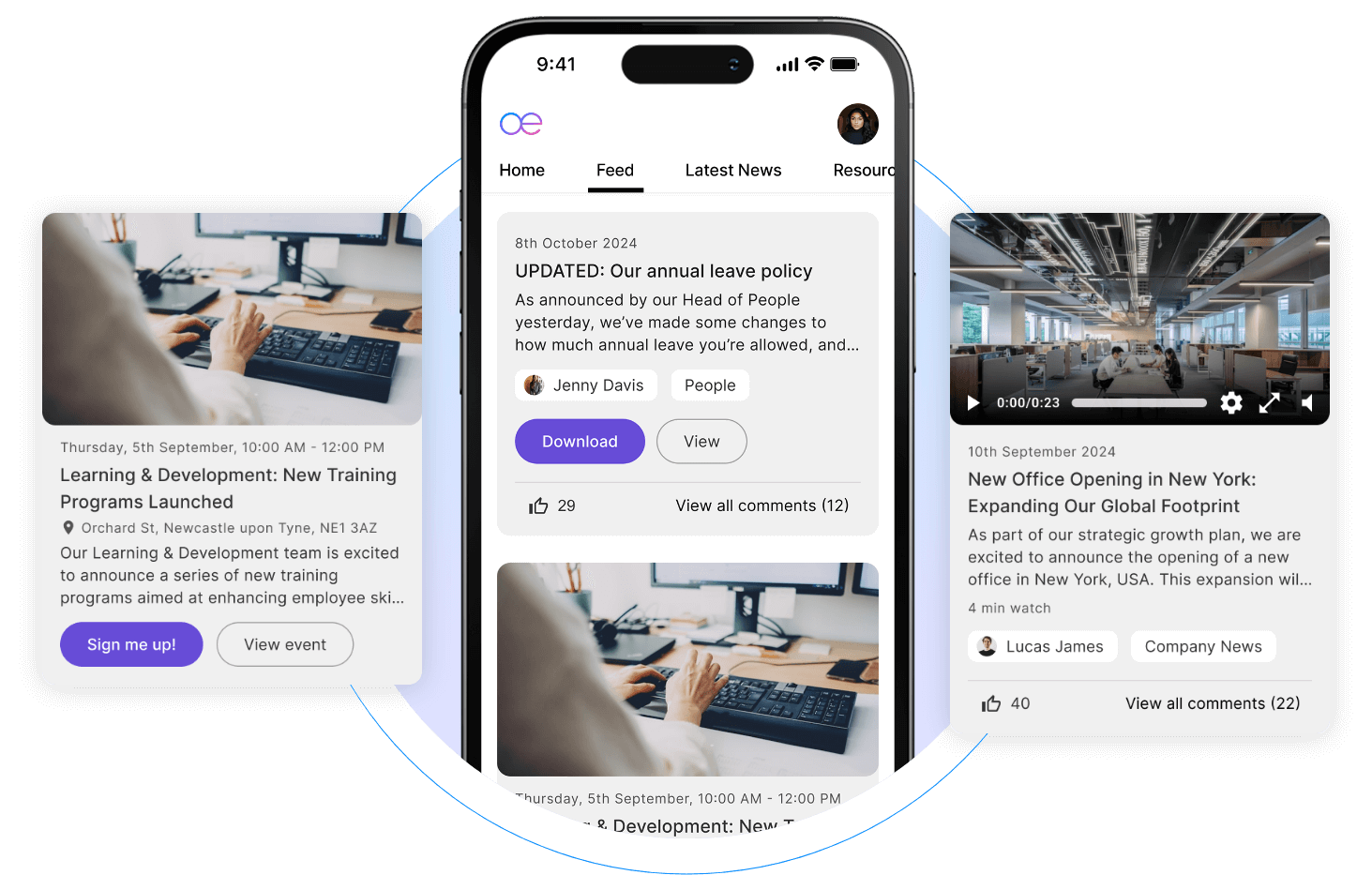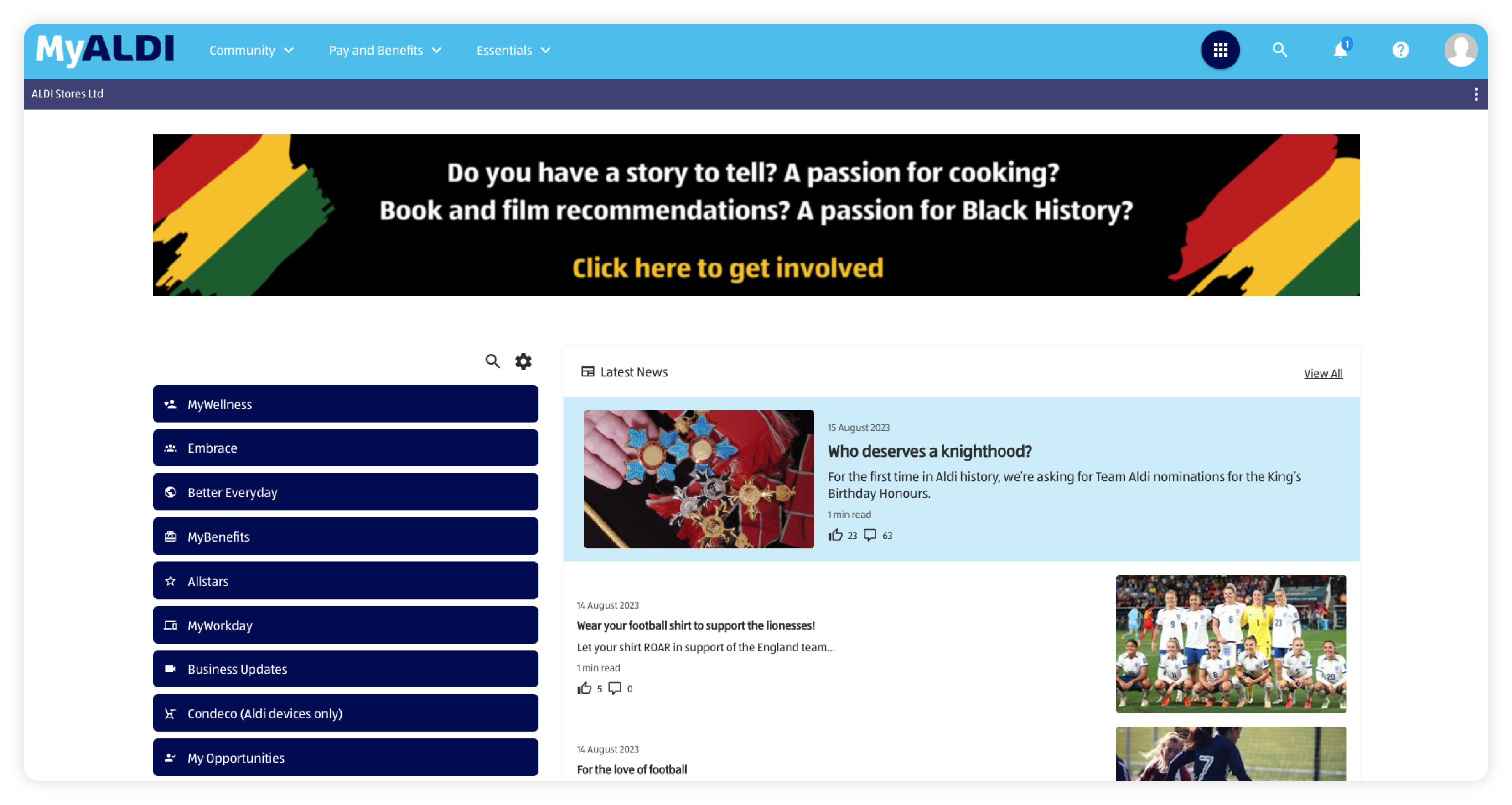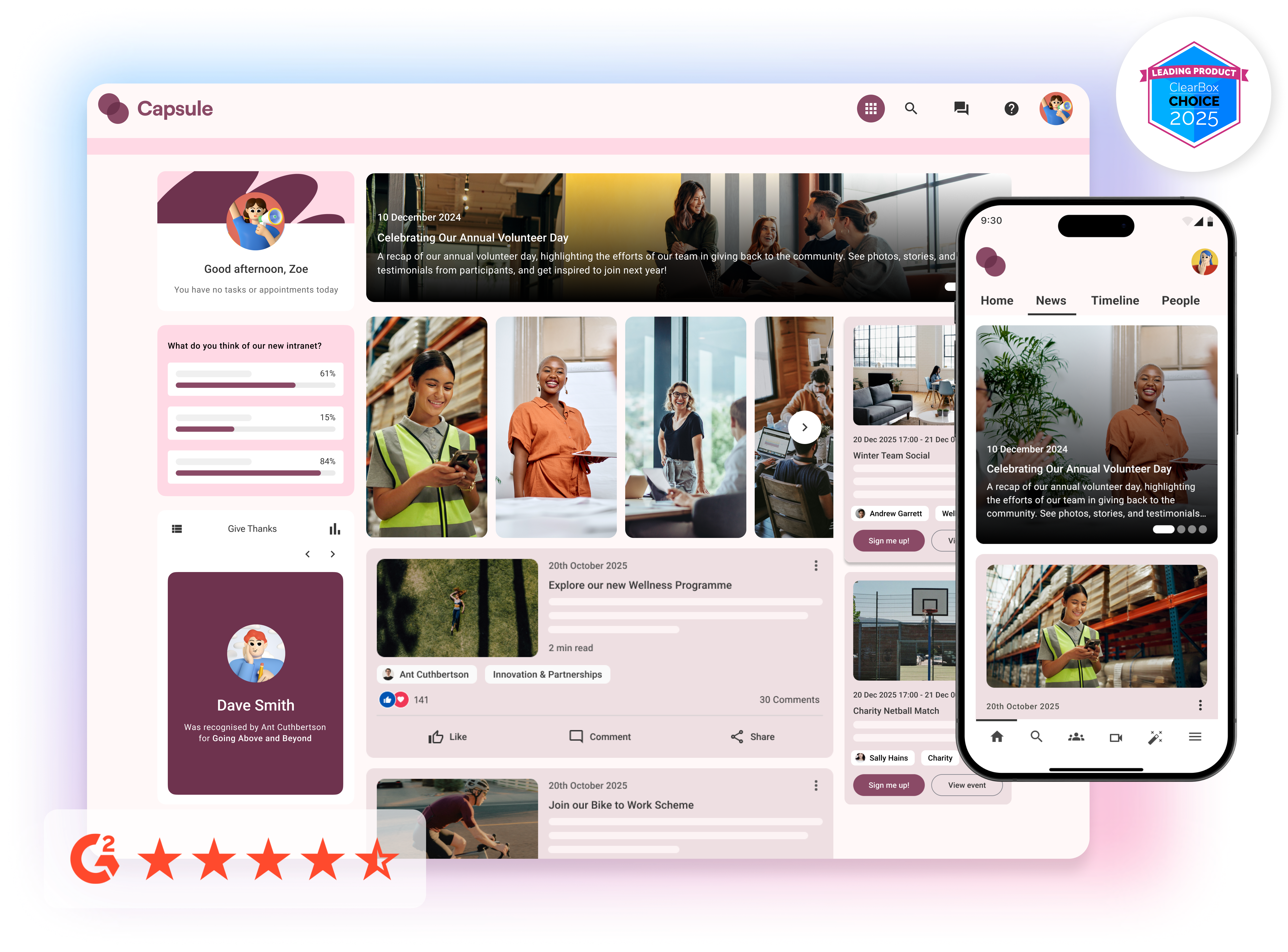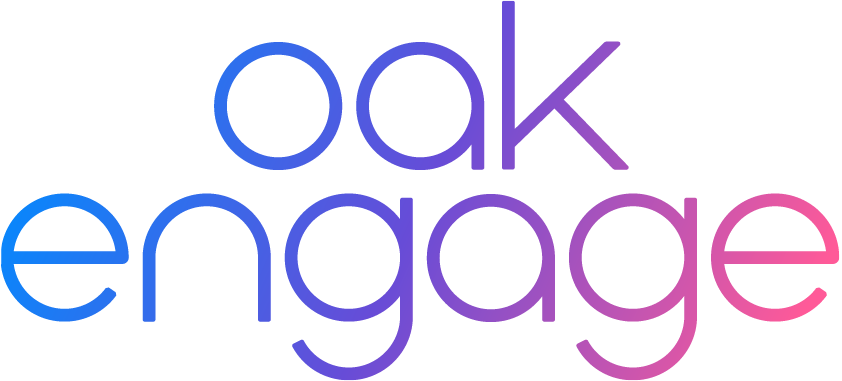With a growing number of employee intranet platforms promising to transform workplace communication and engagement, finding the one that truly fits your organisation can be challenging. That’s why we’re taking a closer look at two of the leading contenders; Oak Engage and Blink.
In this article, we compare both platforms across essential criteria, referencing independent insights from G2 and ClearBox Consulting to offer a balanced, evidence-based assessment. We’ll examine where each solution stands out, from onboarding and customer support to key capabilities such as content personalisation and governance, helping you make a confident, data-informed decision for your teams.
So, if you’re considering implementing an entirely new system, or are looking for a suitable Blink alternative, read on…
What is Oak Engage?
Oak Engage is an award-winning employee engagement app and intranet software designed to connect both desk-based and frontline teams by delivering the right information to the right people at the right moment. Its core mission is to simplify communication, reduce administrative effort, and personalise how messages are delivered across an organisation. Trusted by some of the world’s largest brands, customers of Oak include Five Guys, Burger King UK, NatWest and Aldi.

What is Blink?
Blink is a mobile-first employee experience platform focused on frontline communication, offering an intuitive design that keeps dispersed teams connected.
Both Blink and Oak are recognised leaders in the intranet and employee-engagement platform space, sharing a mobile-first approach for communications, knowledge access and integration with enterprise systems.
Oak Engage vs Blink, industry comparisons
We reviewed insights from leading digital workplace analysts to understand how each platform performs in practice and supports day-to-day employee use. Both Blink and Oak, are consistently recognised as frontrunners in the intranet and employee experience space, though their areas of strength differ in some important ways.
ClearBox Consulting, well regarded for its detailed and impartial evaluations of intranet and digital workplace software, goes beyond vendor messaging to assess real functionality and user impact. Its reviews focus on how effectively each platform supports internal communicators and enhances the overall employee experience.
In its analysis of top-performing intranet offerings, ClearBox highlights Oak as a highly adaptable, intuitive platform with strong integration capabilities and a wide functional scope. The report praises Oak’s user experience and design quality, describing it as “Highly flexible and provides a great user experience.” ClearBox also notes Oak’s strengths in community building and engagement, particularly commending its approach to peer recognition and social connection, “Communities well handled through Hubs. Excellent employee / peer recognition feature.”
By contrast, ClearBox positions Blink as a strong complement to tools typically used by desk-based teams, designed to enhance connectivity and streamline communication across distributed workforces. And so, it becomes clear that a key strength of Oak is that it is designed with both desk based and deskless workers in mind from the get go.
Customer feedback and industry reputation
Independent customer reviews offer crucial insights for anyone evaluating new software. G2, the world’s largest and most trusted software marketplace, features verified user feedback on everything from functionality and usability to service quality.
Both Blink and Blink alternative, Oak, earn strong overall ratings, but a deeper look at specific metrics reveals clear distinctions in where each offer excels.
Employee satisfaction ratings (out of 10) |
Oak Engage |
Blink |
|
Employee communications |
9 |
8.5 |
|
Quality of support |
9.6 |
9.2 |
|
Meets requirements |
9.1 |
9.2 |
Employee communications is one of the areas where Oak truly shines. With a score of 9.0 out of 10 (compared to Blink’s 8.5), Oak’s intuitive and visually engaging design fosters strong adoption and engagement, even across widely distributed teams.
By extension, Oak also demonstrates exceptional strength in employee retention, with G2 reporting a 32% reduction in staff turnover and an impressive 90% retention rate.
In terms of user support, Oak performs strongly once again. G2 reviewers consistently praise the platform’s responsive customer service and the speed with which issues are resolved.
Users on G2 recognise that the simplicity of Blink’s offer does make it relatively straightforward to add on to existing systems, however the depth of Oak’s offer, and its consultative approach to implementation likely mean more impact in the long term.

Oak Engage vs Blink: What are the platform features?
Taking the satisfaction ratings into account, let’s dig a little deeper and consider what might be driving these differences in experience.
When comparing two leading intranet and employee engagement platforms, it’s essential to look past the surface-level features. Both Blink and Oak deliver the fundamentals of a modern digital workplace, providing communication tools, social features, and integrations that help bridge siloes across the organisation. However, finding the best fit for your business means examining how each platform performs against the priorities that matter most to your internal communications strategy. Below, we take a closer look at how both solutions compare, supported by customer insights and independent expert reviews.
Oak Engage vs Blink: Who offers the best customer support?
Quality of support goes far beyond resolving technical issues, it’s about creating a true partnership that underpins the long-term success of your internal communications strategy. Whether you’re launching a new initiative or refining an existing one, a responsive and proactive support team can make all the difference.
Oak places customer success at the centre of its service model, and, given that Oak encompasses both frontline and office-based communications, this support can act as a one stop shop for planning ahead or solving issues. Its dedicated support teams are highly trained, attentive, and committed to guiding clients through every stage of the journey.
Oak consistently achieves customer satisfaction ratings above the industry average, thanks to a personalised and hands-on approach that stands out from many enterprise providers, where support is often limited to ticket-based or self-service systems.
How Oak partnered with Aldi
Since partnering with Oak in 2017 to launch MyALDI, Aldi has seen continuous growth in employee engagement, motivating ongoing platform enhancements. Charlotte Timmins, Communication Manager at Aldi UK, said:
“The Oak team is both incredibly helpful and knowledgeable. Together with our Internal Comms team, they ensure that MyALDI is the most engaging, connective platform possible; and they’re always ready to offer ideas for new developments and technical support.”
ClearBox feedback about Oak’s customer service is overwhelmingly positive, with clients describing the team as “great”, “excellent”, and “fantastic”. One customer noted, “Everyone is really helpful and proactive – a joy to work with,” while another described the experience as “10/10” and said they have “a great relationship with the team at Oak.” Many reviewers emphasised Oak’s commitment to “helping you get the most out of the product”, ensuring the platform continues to evolve with their organisation’s needs. This emphasis on relationship-building means customers aren’t just investing in software – they’re gaining a long-term partner dedicated to their success.
Blink’s support, meanwhile, is praised for its responsiveness and openness to feedback. However, its simpler, more streamlined product may offer fewer opportunities for consultancy or customisation. For larger enterprises with established internal IT or communications teams, this model can work well. But, for organisations seeking broader integration, more in-depth guidance and an actively consultative relationship, Oak’s customer success–focused approach often proves a better fit.

Oak Engage vs Blink: Which platform offers optimal features for information distribution?
In today’s fast-moving digital workplace, effective information distribution is vital for ensuring that every employee — whether office-based, remote, or on the frontline — receives timely, relevant updates that keep them informed, connected, and aligned with organisational goals. The ability to deliver accurate information quickly and consistently can make the difference between engagement and disengagement, particularly in large or dispersed workforces.
According to G2, Oak earns an outstanding 10/10 rating for its news feed, compared with Blink’s 9.2. This reflects Oak’s unwavering focus on real-time communication and its seamless accessibility for all employees. G2 also rates Oak’s notification system particularly highly (9.7 versus Blink’s 8.9), recognising its strength in driving engagement through personalised, targeted updates.
Superior content management
The Oak news feed is supported by intranet-grade tools for managing content, documents, policies, and workflows, which in turn enables greater version control, compliance and governance than providers that serve more as simple content sharing platforms.
Another area where Oak stands out is in multi-channel distribution. Its ability to share information instantly across multiple communication channels enables full integration and company-wide reach with minimal effort.
For industries with high-volume, time-sensitive, and targeted communication needs — such as retail, healthcare, logistics, manufacturing, and hospitality — this functionality is essential. It ensures that HR, operations, and internal communications teams can deliver critical messages quickly and reliably, so everyone who needs to know, knows right away.
While Blink also supports multi-channel information sharing, it scores more strongly in newsletter and email functionality. So, as a Blink alternative, Oak’s always-on, cross-channel news feeds and real-time notifications give it a distinct advantage for organisations that prioritise agility, immediacy, and continuous engagement.

Oak Engage vs Blink: Which is best for employee engagement?
True employee engagement goes beyond simply sharing information — it’s about creating a workplace where people feel heard, valued, and motivated to contribute. Engagement reflects how emotionally and psychologically invested employees are in their organisation’s mission and daily operations. One of the most reliable indicators of engagement is interaction: when employees actively comment, respond, and participate, it shows that communication is two-way and that people feel empowered to take part in shaping the culture.
Oak excels in driving this kind of meaningful interaction. According to G2, Oak achieved a perfect 10/10 score for content interaction among reviewers. It also received exceptional ratings for confirmations, a feature that helps close the loop on key HR processes and communication bottlenecks. Oak’s advanced analytics functions further strengthen its offering, simplifying the process of tracking, measuring, and improving engagement across the organisation.
Commenting is another area where Oak clearly leads, earning another flawless 10/10 rating. This shows how confidently employees engage with content — not just consuming information but responding, sharing ideas, and building dialogue.
Engagement made easy
This sense of empowerment extends into the administrative experience as well. One ClearBox reviewer noted: “The product has an attractive interface, [is] intuitive to use and functions really well with a wide range of tools.” Others commented that “putting together engaging pages is very quick and easy” and praised the “multitude of options in terms of layout and use for the various applications.” Customers also highlighted Oak’s “search functions and document management” and its strong “support for deskless workers.” As one user put it, “The platform helps us engage and communicate, which has improved overall team performance.”
Overall, G2 reviewers report that Oak takes a more comprehensive approach to employee engagement features, particularly in areas such as gamification and community building, where it scores 9.3.
Blink’s simpler, less customisable offering performs best in survey-based engagement, making it a strong option for organisations seeking to gather broad feedback and high-level insights rather than drive continuous, participatory interaction.

Oak Engage vs Blink: Which platform is best for customisation?
Personalisation in user experience (UX) is about tailoring content, functionality, and design to meet the specific needs of each user. In the context of employee engagement, personalisation ensures that individuals see the most relevant information, tools, and updates for their role, location, and device, creating a more meaningful and efficient experience that strengthens connection and reduces digital noise.
ClearBox highlights Oak’s strong performance in this area, noting that its “intelligent audience targeting works well for mobile. App experience can be tailored to the frontline. Helpful in-built tools.”
Customisation across devices
The report also praises the degree of control administrators have over Oak’s design, including on mobile devices, with options for custom branding. Dedicated homepages allow frontline workers to access only the features most relevant to them — such as timelines and notices — while broader audiences can share a unified homepage, with individual applets configured to display based on audience type or device.
A G2 user review by Bethan, an Employee Engagement Officer for a mid-sized company, summarised the experience perfectly, “It's easy! Everything about Oak Engage is easy, simple and fun — from creating pages, dealing with the team, implementing new elements, and communicating with our staff.”
While Blink earns recognition for its strong API compatibility and detailed reporting dashboards, as an alternative option, Oak edges ahead in overall personalisation (scoring 8.6) and mobility (9.4). Its adaptive interface and audience-targeting capabilities make it particularly well suited for organisations that need to reach diverse, distributed, and mobile-first teams with precision and ease.
Oak Engage vs Blink: How do the platforms compare on pricing?
When it comes to employee engagement, there’s no universal solution. Every organisation has its own communication challenges, cultural nuances, and engagement priorities. That’s why it’s vital to choose an intranet that balances flexibility, functionality, and value.
Blink appeals to enterprises looking for a mobile-first, ready-to-use communications platform. However, its pricing for larger organisations is generally higher than Oak’s. For businesses seeking a more personalised, hands-on partnership — one where your organisation receives dedicated attention rather than becoming just another account — it’s worth considering solutions that prioritise tailored support and adaptability.
Oak offers cost-effective options with flexible pricing models designed to meet the needs of organisations of all sizes, especially those with large frontline or hybrid workforces. For companies that value responsive service, rapid implementation, and rich communication features, Oak delivers a comprehensive, high-quality platform without unnecessary cost.
Oak can be tailored to your business needs. Reach out to our team to find the perfect fit for your people and your goals.
Oak Engage vs Blink: The final verdict
When comparing Oak and Blink, four key areas highlight how the platforms differ in scope and focus.
Breadth of platform: Blink excels in frontline communication, whereas Oak takes a step further by delivering a unified platform that serves both frontline and office-based employees. This dual capability makes it a more versatile solution for organisations with hybrid or mixed workforce structures.
Information management: Oak’s intranet-grade tools for managing documents, policies, and workflows provide far greater depth than Blink’s simpler, content-sharing functionality. This allows organisations to centralise resources, maintain governance, and ensure compliance, while still keeping content easy to create and distribute.
Engagement analytics and insights: G2 acknowledges how Oak’s personalisation capabilities deepen employee engagement, and ClearBox praises Oak for its “robust analytics suite” that empowers communicators with meaningful data and actionable insights. This gives Oak a clear advantage over Blink’s more message-focused dashboards, enabling teams to target communications, and then measure impact, optimise engagement strategies, and demonstrate the value of internal communications.
Support and service: Both platforms are recognised for excellent customer support, but Oak edges ahead with a G2 score of around 9.5 compared to Blink’s 9.2. Oak’s focus on silo-busting impact, guided onboarding, ongoing partnership, and proactive customer success helps organisations achieve smoother implementation and stronger long-term performance.
If your priorities include uniting both frontline and office-based employees on a single platform, managing cross channel messaging with confidence, gaining deeper insight through advanced analytics, and working with a partner that provides responsive, long-term support, then Oak stands out as the stronger, more comprehensive choice.
How to choose an employee intranet platform
As with any platform investment, it’s important to start by asking the right questions:
· What does an effective employee intranet look like for your organisation?
· Can the platform be customised to align with your brand, communication style, and diverse team needs?
· How much long-term support will you need from your intranet partner?
· What level of security and data protection is essential for your organisation?
If these are the questions driving your internal communications strategy, Oak may well be the ideal solution for your organisation. To help guide your decision, we’ve also compared Oak with other leading providers, including Unily and Interact.
Get in touch today to find out how Oak can unify your whole organisation and transform your internal communications into a real success story.
Change the way you work. Empower your people
We offer a free and personalised demo service, showcasing our intuitive and easy to use platform.




